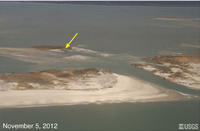-
Con Ed overcame many obstacles to restore power to NYC
On 29 October Hurricane Sandy slammed into New York City and took out the power in most of Lower Manhattan, even knocking out power to the headquarters of Consolidated Edison’s (Con Ed), the electricity supplier for NYC; due to the flooding in Lower Manhattan, employees had to use rafts to rescue coworkers trapped in the company’s East 13th Street power station; in the days after the storm, as with many other New Yorkers, Con Ed almost ran out of gas, but that did not stop the company from restoring power back to Lower Manhattan less than four days after the storm
-
-
Hurricane Sandy caused dramatic changes to hundreds of miles of East Coast shoreline

The United States Geological Survey (USGS) has released a series of aerial photographs showing before-and-after images of Hurricane Sandy’s impacts on the Atlantic Coast; the photos, part of a USGS assessment of coastal change from as far south as the Outer Banks of North Carolina to as far north as Massachusetts, show that the storm caused dramatic changes to portions of shoreline extending hundreds of miles
-
-
New fluorescence technology pinpoints oil leaks at sea
Cambridge Consultants uses fertility monitor technology in oil leak early warning system; the company has built an oil spill detection technology platform which is capable of detecting the natural fluorescence of even tiny amounts of oil in or on water
-
-
Plants, soils could exacerbate climate change as global climate warms

Scientists have demonstrated that plants and soils could release large amounts of carbon dioxide as global climate warms; this finding contrasts with the expectation that plants and soils will absorb carbon dioxide and is important because that additional carbon release from land surface could be a potent positive feedback that exacerbates climate warming
-
-
Sea-level records reveal tight correlation between ice volume and polar temperature

During the last few million years, global ice-volume variability has been one of the main feedback mechanisms in climate change, because of the strong reflective properties of large ice sheets. Ice volume changes in ancient times can be reconstructed from sea-level records; a new study has revealed a rapid response between global temperature and ice volume/sea-level, which could lead to sea-levels rising by over one meter
-
-
In 2009, engineers predicted surge threats to N.Y.-N.J. and offered detailed mitigation measures
The leaders of the U.S. top engineering association, reflecting on the destruction inflicted by Superstorm Sandy, say that more than three years ago the association presented studies showing that a devastating storm surge in the region was all but inevitable; participants in the 30-31 March 2009 American Society of Civil Engineers (ASCE) conference called on NYC officials seriously to consider whether to install surge barriers or tide gates in New York Harbor to protect the city
-
-
New book discusses storm surge protection for New York City

A new book from American Society of Civil Engineers (ASCE), to be published on 3 December, includes sixteen papers exploring the development of storm surge barriers to protect New York City and nearby New Jersey from the effects of a future deluge
-
-
Increasing the efficiency of wireless networks
A “spectrum crunch” is quickly being accelerated as customers convert from traditional cell phones to smartphones and tablets; new method, which doubles the efficiency of wireless networks, was developed by researchers; it could have broad impacts on the mobile Internet and wireless industries
-
-
In Pennsylvania, the U.S. mecca of fracking, more scientific research is urged
Hydraulic fracturing or fracking is a controversial method to extract natural gas or petroleum from subterranean shale by using pressurized water to blast it open; proponents of fracking have noted its potential for helping the United States achieve energy independence while also stimulating the economy and creating jobs; these proponents have met stiff resistance from environmental groups that claim fracking can result in air and water pollution and have adverse human health effects
-
-
Bottler wants to pump more water in Florida to send to Sandy’s victims, but the locals are angry
Niagara Bottling LLC Is attempting to boost the amount of water it pumps from the Floridan Aquifer in Central Florida to help victims of Hurricane Sandy, but it is unclear whether the help is needed
-
-
“Groundwater inundation” doubles previous predictions of flooding with future sea level rise

Scientists published a study today showing that besides marine inundation (flooding), low-lying coastal areas may also be vulnerable to “groundwater inundation,” a factor largely unrecognized in earlier predictions on the effects of sea level rise (SLR)
-
-
Stunt kites raise wind power to another level

Researchers are sending stunt kites into the skies to harness the wind and convert the kinetic energy generated into electricity; the kites fly at a height of 300 to 500 meters, positioned to be caught by strong winds; cables, about 700 meters in length, tether the kites to vehicles and pull them around a circuit on rails; a generator then converts the kinetic energy of the vehicles into electricity
-
-
New tool for incorporating water impacts into policy decisions

Just-released paper offers policy makers innovative framework for linking human well-being and water quality; a new tool helps in assessing and valuing the many services clean water provides — from recreation and beauty to navigation and hydropower — and incorporating them into policy decisions
-
-
CIA-commissioned climate change report outlines perils for U.S. national security
U.S. national security leaders believe that the accelerating pace of climate change will place severe strains on U.S. military and intelligence agencies in coming years; the reason, according the National Research Council, the U.S. top scientific research body: climate changes will trigger increasingly disruptive developments around the world; a 206-page National Research Council study, commissioned by the CIA and other U.S. intelligence services, concludes that states will fail, large populations subjected to famine, flood, or disease will migrate across international borders, and national and international agencies will not have the capacity or resources to cope with the resulting conflicts and crises
-
-
Michigan launches Cyber Range – a cutting-edge cybersecurity training program
Michigan has launched the Michigan Cyber Range, a state-of-the-art facility that prepares cybersecurity professionals in the detection and prevention of cyber attacks; the initiative pairs cybersecurity resources with hands-on training opportunities to enhance Michigan’s protection of computer systems and sensitive data
-
- All
- Regional
- Water
- Biometrics
- Borders/Immig
- Business
- Cybersecurity
- Detection
- Disasters
- Government
- Infrastructure
- International
- Public health
- Public Safety
- Communication interoperabillity
- Emergency services
- Emergency medical services
- Fire
- First response
- IEDs
- Law Enforcement
- Law Enforcement Technology
- Military technology
- Nonlethal weapons
- Nuclear weapons
- Personal protection equipment
- Police
- Notification /alert systems
- Situational awareness
- Weapons systems
- Sci-Tech
- Sector Reports
- Surveillance
- Transportation
Advertising & Marketing: advertise@newswirepubs.com
Editorial: editor@newswirepubs.com
General: info@newswirepubs.com
2010-2011 © News Wire Publications, LLC News Wire Publications, LLC
220 Old Country Road | Suite 200 | Mineola | New York | 11501
Permissions and Policies
Editorial: editor@newswirepubs.com
General: info@newswirepubs.com
2010-2011 © News Wire Publications, LLC News Wire Publications, LLC
220 Old Country Road | Suite 200 | Mineola | New York | 11501
Permissions and Policies
